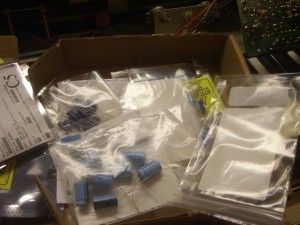The other morning I heard a great story on NPR about people in China and their interest in basketball. I was really interested to learn how they believed basketball allowed them to express their individuality. One of them dreamed out loud of being able to dunk and how this was their ultimate dream of freedom.
Aside from the question of how many different ways there are to dunk, it got me thinking about Chinese culture and how it has contributed to their success over the past 8 years or so. It is no secret that the Chinese culture, and specifically the government, stresses conformity. One might think that this would hinder the technological progress in China, but they are quickly becoming a technology leader in the world (it is important to note that a good deal of the continued success of China is companies outside the country driving progress…but not all of it). Add to that how more and more design work is being offshored, due to the low cost and higher supply of design engineers. A slew of questions have popped up in my mind when I think about these kinds of things.
Does conformity hurt a culture?
I would argue that when it comes to academics and business, conformity helps. In school, this is obvious. If you are in a classroom with 50 other students, every student is expected to know that 2 + 2 = 4. Sure, this is a simple example, but the academic system is usually based upon reaching a solution that someone else (the textbook, your teacher, the government, etc) wants you to reach. Further, the extremely competitive nature of academia in China has parents encouraging this behavior, even outside the structures of academia (no, I am not suggesting that 2 + 2 does not equal 4, nor that you should tell your teacher so to be unique, just that conformity can travel beyond the walls of a school). Academic stress happens in America too, I just feel like it is more ubiquitous in China.
What about in business? This too has some benefits. Think about a production line in China, cranking out iPod after iPod, all made to be the exact same, with the outliers and the bad production techniques tweaked to remove these expensively bad units. The faster each unit can be made the same, the cheaper that unit will be, and the happier the company selling it will be. The concept was created in the wake of World War 2, when the Japanese began to focus heavily on quality control; today, the Chinese benefit from these methods of conformity.
So business and school both seem to be havens for conformity. But what about situations that require some ingenuity? What happens when the product that is made so fast and becomes so cheap and ubiquitous that the public is clamoring for a newer and shinier device? (an iPhone instead of an iPod, for example) Who will create the technology that will drive the next revolution? What about when there are students that rise to the top of their class and go on to get a PhD? What happens when the smartest student goes to the best school and gets the highest degree possible after conforming to all the standards placed before them? Then they stare out into the abyss and try to figure out something new, only to realize that no one is there telling them what they need to figure out. I’m not saying this happens, only that it is an interesting scenario and it begs the question: is absolute conformity a good thing?
Is the academic system set up for failure eventually?
This is an extension of the above idea about PhD students. I know many PhD students (in the US) who tell me about their research being only that which their advisor wants. Further, while they are working on their research, they are hoping and praying that there are not any other students about to publish similar results as their own. Perhaps this is why we see more PhD students who are from outside the US (studying at US schools) or are getting PhDs at international institutions–because the fastest paper published is the most important, not the most creative. Perhaps the conformity aspect of academia extends beyond the simple math equations into the upper echelons of higher education. I think the scariest part is the students who eventually become the teachers. If you think about the rigor involved in obtaining a professorship these days, it can include 1 or more PhDs, multiple post doctorate positions and continual paper publishing throughout one’s career. This basically means that the most astute students of the system (those that best navigate the conformity requirements placed upon them) are the ones that become the teachers. These same people then expect the same (or more!) out of the rising students. One has to wonder when this sort of thing will stop.
Another point about the academic system that confuses me is whether or not the students who exhibit some amount of individuality are more or less successful. I would like to think that those with bright new ideas rise to the top, but I am not so sure that this happens. Perhaps instead the ones that conform the quickest and those with the best advisors do the best. Personally, I have never heard of an academic phenom that did not have a spectacular advisor guiding them through the world of academics.
What is individuality?
Well, the idea is that an individual is capable of defining themselves as different from all other people. Does this happen very often? No, of course not. Even this article I am writing now has been conceived and written about many times over. But I view individuality as the opposite of conformity; it is bucking the norm, even if others do too (some small amount of them, of course. If the majority buck the trend, it becomes the new trend).
How does individualism affect creativity?
Creativity is a nebulous and fickle thing. Further, I don’t think that individuality breeds creativity; instead, I believe creativity breeds individuality. This is important to engineering because without creativity, engineering would essentially stop in its tracks. There would be no new methods, no new products, no intellectual progress. Most importantly (and realistically), there would be no financial gain and therefore no more funding to teach and advance engineering. Of course this also extends outside of engineering; art programs, humanities, economics, language (?)…none of these would be funded if there was no creativity and new ideas. Instead, the money would focus on getting the best value from what is already being made. If this is the case, Seth Godin points out not to follow the money.
Does too much individualism breed a sense of entitlement?
I think it’s important to view the other side of this issue. What happens when students are given the freedom to express themselves and the means to do so? In the extreme cases, I think that students are more prone to laziness, replication (copying others) and a sense of entitlement. Let’s look at an American student as it is interesting to contrast the difference from a Chinese student. Many newly graduating students are demanding higher salaries, more responsibilities and have less experience. Some people justify it (and rightly so), but does that mean we’re worth the more than our last generation? I’m not so sure.
C’mon people, of course the extremes of conformity and individualism will have their faults. Of course there will be some mixing of the two that will produce the best engineers and the best students. However, I would really love to hear from you about your opinions on individuality and conformity.





